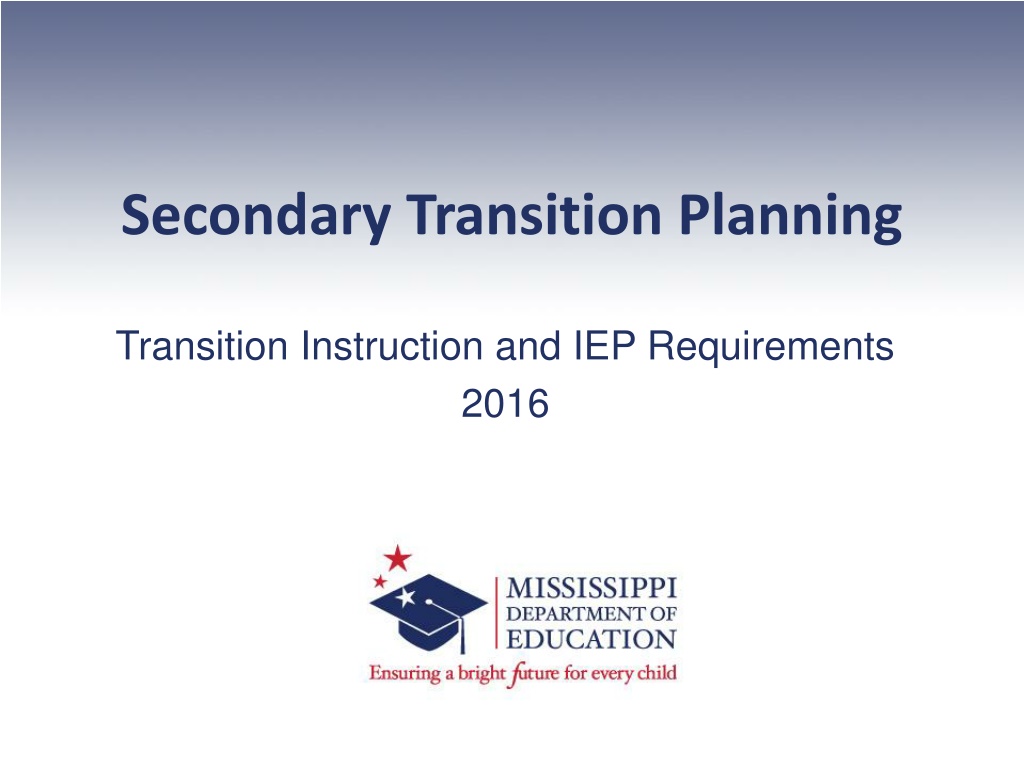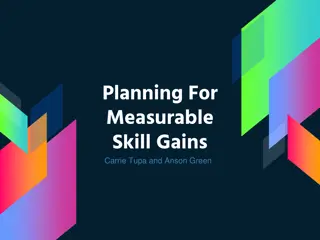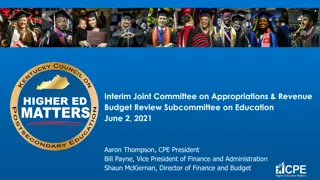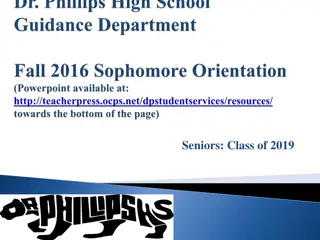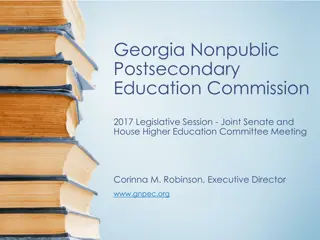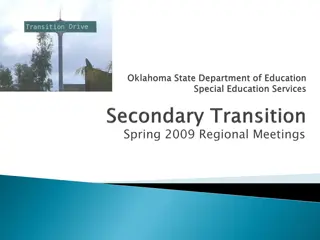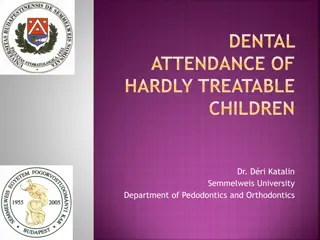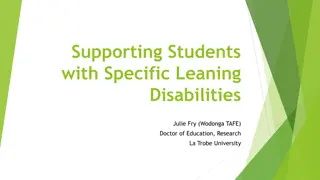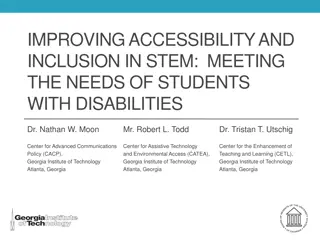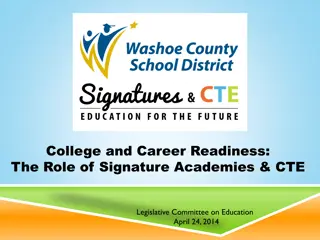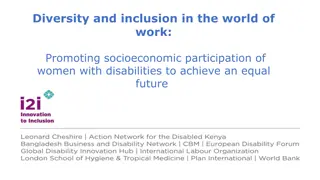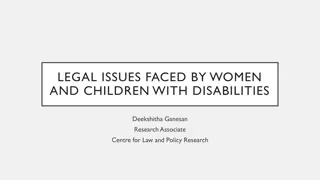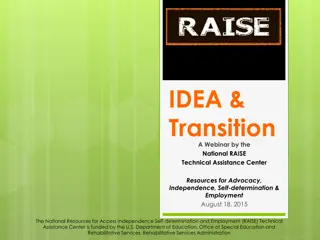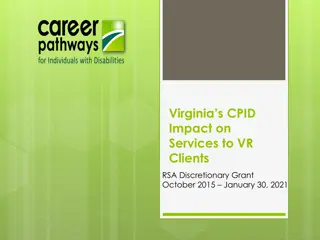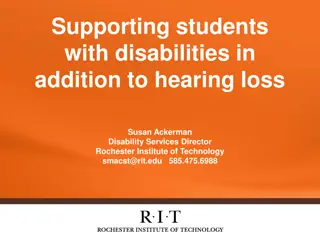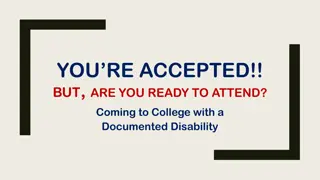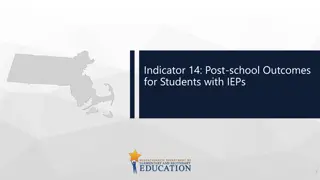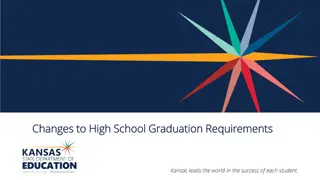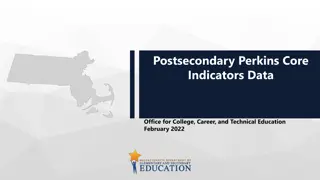Enhancing Postsecondary Success for Students with Disabilities
Promoting successful transitions for students with disabilities is crucial to improving postsecondary outcomes. Addressing transition planning ensures students are equipped with the necessary knowledge and skills for college, career, and independent living. By focusing on effective transition instruction and IEP requirements, educational institutions can help students with disabilities thrive in the workforce and society.
Download Presentation

Please find below an Image/Link to download the presentation.
The content on the website is provided AS IS for your information and personal use only. It may not be sold, licensed, or shared on other websites without obtaining consent from the author. Download presentation by click this link. If you encounter any issues during the download, it is possible that the publisher has removed the file from their server.
E N D
Presentation Transcript
Secondary Transition Planning Transition Instruction and IEP Requirements 2016
Vision and Mission of MDE Vision To create a world-class educational system that gives students the knowledge and skills to be successful in college and the workforce, and to flourish as parents and citizens Mission To provide leadership through the development of policy and accountability systems so that all students are prepared to compete in the global community Secondary Transition Planning Office of Special Education
State Board of Education Goals Strategic Plan 1. All Students Proficient and Showing Growth in All Assessed Areas 2. Every Student Graduates From High School and is Ready for College and Career 3. Every Child Has Access to a High-Quality Early Childhood Program 4. Every School Has Effective Teachers and Leaders 5. Every Community Effectively Using a World-Class Data System to Improve Student Outcomes 6. Every School and District is Rated C or Higher Secondary Transition Planning Office of Special Education
Why Plan for Transition? Are we limiting our students? Think College How have you addressed transition with your students? Why is transition planning important for students with disabilities? Secondary Transition Planning Office of Special Education 4
Current Postsecondary Outcomes for Students with Disabilities Individuals with disabilities have the highest rate of unemployment of any group. More than twice that of people without disabilities. More than two-thirds do not participate in workforce at all. Students with disabilities are less likely to enroll in postsecondary education and are less likely to live independently than their nondisabled peers. Secondary Transition Planning Office of Special Education 5
Current Postsecondary Outcomes for Students with Disabilities According to 2010 America Community Survey (ACS): Students with disabilities, including cognitive disabilities, who attain any level of postsecondary education have better employment outcomes than those without any postsecondary education. Secondary Transition Planning Office of Special Education 6
Do you see disabilities or abilities? Unrecognized potential and ability in school can result in wasted time and delayed or NO access to postsecondary dreams and goals. We must see impairments and needs but we must LOOK for and strengthen abilities! Everyone has a purpose, interests, and abilities! Secondary Transition Planning Office of Special Education 7
Definition of Transition A coordinated set of activities for a child with a disability that: Is within a result-oriented process. Is focused on improving academic and functional achievement. Secondary Transition Planning Office of Special Education 8
Definition of Transition Facilitates child s movement from school to post-school activities, including: Postsecondary Education Continuing and Adult Education Vocational Training Employment (Integrated or supported) Adult Services Independent Living Community Participation Secondary Transition Planning Office of Special Education 9
Definition of Transition Is based on the child s needs, strengths, preferences, and interests. Includes instruction, related services, community experiences, the development of employment and other post-school adult living objectives. When appropriate, includes acquisition of daily living skills and functional vocational evaluation. (IDEA,2004) Secondary Transition Planning Office of Special Education 10
Definition of Transition IDEA 2004 states: Beginning not later than the first IEP to be in effect when the child turns 16, or younger if determined appropriate by the IEP Committee, and updated annually thereafter. State Board Policy Chapter 74, Rule 74.19: Beginning not later than the first IEP to be in effect when the child turns 14, or younger if determined appropriate by the IEP Committee, and updated annually thereafter. Secondary Transition Planning Office of Special Education 11
Transition At-a-Glance Postsecondary Outcomes College or University Job Corps Competitive Employment Supported/Integrated Employment Military Career/Technical School Apprenticeships/Internships Customized Employment Secondary Transition Planning Office of Special Education 12
What is Indicator 13? All states must submit Annual Performance Reports (APR) to the U.S. Department of Education through the Office of Special Education Programs around 20 IDEA related indicators. Indicator 13 relates to transition services for students with disabilities. Secondary Transition Planning Office of Special Education 13
What is Indicator 13? Indicator 13 measures: Percent of youth aged 16 (age 14 for the state of Mississippi) and above with an IEP that includes appropriate measurable postsecondary goals that are annually updated and based upon an age appropriate transition assessment, transition services, including courses of study, that will reasonably enable the student to meet those postsecondary goals, and annual IEP goals related to the student s transition services needs. Secondary Transition Planning Office of Special Education 14
What is Indicator 13? Indicator 13 measures (cont.): There also must be evidence that the student was invited to the IEP Team meeting where transition services are to be discussed and evidences that, if appropriate, a representative of any participating agency was invited to the IEP Team meeting with the prior consent of the parent or student who has reached the age of majority. (20 U.S.C. 1416(a)(3)(B)) Secondary Transition Planning Office of Special Education 15
Indicator 13 Checklist 1. Is (are) there a measurable, appropriate postsecondary goal or goals that covers: Education or training? Employment? Independent living, as needed? Are the postsecondary goals updated annually? 2. Secondary Transition Planning Office of Special Education 16
Indicator 13 Checklist 3. Is there evidence that the postsecondary goals were based on age appropriate transition assessment(s)? Secondary Transition Planning Office of Special Education 17
Indicator 13 Checklist 4. Are there transition services in the IEP that will reasonably enable student to meet his or her postsecondary goals? Secondary Transition Planning Office of Special Education 18
Indicator 13 Checklist 5. Do the transition services include courses of study that will reasonably enable student to meet his or her postsecondary . Secondary Transition Planning Office of Special Education 19
Indicator 13 Checklist 6. Is (are) there annual IEP goal(s) related to the student s transition services needs? Secondary Transition Planning Office of Special Education 20
Indicator 13 Checklist 6. Is (are) there annual IEP goal(s) related to the student s transition services needs? (continued) The number listed for related IEP goal(s) must match annual goal(s) aligned to the postsecondary goal. The IEP goals should address areas of need that may impact the student s ability to pursue his or her postsecondary goals. These areas of need must be identified in the PLAAFP. Therefore, when checking compliance to #6 the following areas on the IEP will be examined: PLAAFP, related IEP goals listed with postsecondary goals, and the numbers of related IEP goals listed with postsecondary goals. All 3 areas should align. Secondary Transition Planning Office of Special Education 21
Indicator 13 Checklist 7. Is there evidence that the student was invited to the IEP Committee meeting where transition services were discussed? Secondary Transition Planning Office of Special Education 22
Indicator 13 Checklist 8. If appropriate, is there evidence that a representative of any participating agency was invited to the IEP Committee meeting with prior consent of the parent or student who has reached the age of majority? Secondary Transition Planning Office of Special Education 23
A Transition-Rich IEP Transition Assessment and Present Levels of Academic Achievement and Functional Performance Measurable Postsecondary Goals Designated Responsibility Annual IEP Goals Annual Activities and Services, Including Course of Study Secondary Transition Planning Office of Special Education 24
Student Involvement Evidence of student invitation to IEP Committee meeting is documented in the IEP or cumulative folder (e.g. a letter inviting the student to the meeting). Dated prior to IEP Meeting. Secondary Transition Planning Office of Special Education 25
Age-Appropriate Transition Assessments Postsecondary goals must be based on age- appropriate assessments. Transition assessment is the ongoing process of collecting data on a student s needs, preferences, and interests as they relate to the demands of current and future employment, educational, living, personal and social environments. Forms the basis for defining goals and services to be included in IEP. Secondary Transition Planning Office of Special Education 26
Age-Appropriate Transition Assessments At least one age-appropriate transition assessment for each postsecondary goal. Assessment may be formal, informal, or combination of both. Must provide information on student s needs, strengths, preferences, and interests. Secondary Transition Planning Office of Special Education 27
Age-Appropriate Transition Assessments Examples of Formal Assessments: Adaptive Behavior/Daily e.g. Vineland Adaptive Behavior Scales Aptitude Tests e.g. TABE, Armed Services Vocational Aptitude Battery, OASIS-III Aptitude Survey Achievement Tests e.g. Woodcock Johnson III, Kaufman Test of Individual Achievement Interest Inventories e.g. iCAP Secondary Transition Planning Office of Special Education 28
Age-Appropriate Transition Assessments Examples of Informal Assessments: Parent Interviews/Surveys Student Interviews/Surveys Observation Classroom, community, work Checklists Work Samples Informal Interest Inventories Casey Life Skills Curriculum-Based Assessments e.g. Brigance Life Skills Inventory, Brigance Transition Skills Inventory, Unique Learning Systems Transition, CEC Life- Centered Education Secondary Transition Planning Office of Special Education 29
Resources for Assessments Websites with formal and informal assessments: National Center on Secondary Education and Transition http://www.ncset.org/topics/career/default.asp?topic=1 Zarrow Center at University of Oklahoma http://www.ou.edu/content/education/centers-and- partnerships/zarrow/transition-assessment---severe- disabilities.html South Bend Community School Transition Assessments and Activities http://sped.sbcsc.k12.in.us/ppm/transitionplanning/trans itionassessments.html Secondary Transition Planning Office of Special Education 30
Resources for Assessments ESTR Publications Enderle-Severson Transition Rating Scale. $20 per 10 reports. http://www.estr.net/index.cfm Casey Life Skills http://lifeskills.casey.org/ Transition Assessment Matrix http://www.iidc.indiana.edu/styles/iidc/defiles/CCLC/tr ansition_matrix/Transition_Matrix.html Pictorial Career Interest http://achieve.lausd.net/Page/6088 Secondary Transition Planning Office of Special Education 31
Resources for Assessments Career Cluster Videos http://www.careeronestop.org/Videos/CareerandClust erVideos/career-and-cluster-videos.aspx Transition Assessment for Autism http://achieve.lausd.net/cms/lib08/CA01000043/Centri city/Domain/220/Transition%20and%20Vocational%20 Skills%20assessment.pdf QuickBook of Transition Assessments http://www.ocali.org/up_doc/Quickbook_of_Transition _Assessment.pdf Secondary Transition Planning Office of Special Education 32
Resources for Assessments Task Analysis: written list of the discrete steps required to complete a task, such as doing laundry, brushing teeth, mopping a floor, setting a table, maintaining a work setting, etc. Website with samples: http://www.ttacnews.vcu.edu/2012/08/task-analysis- teaching-multistep-skills-made-easy/ Secondary Transition Planning Office of Special Education 33
Resources for Assessments Employment Support Indicators http://www.ouhsc.edu/thecenter/products/ESI.asp Community Based Skills Assessment https://www.autismspeaks.org/sites/default/files/docu ments/family- services/community_assessment_tool_kit.pdf Secondary Transition Planning Office of Special Education 34
Age-Appropriate Transition Self- Determination Assessments Self-Determination includes: Self-awareness Self-efficacy Self-advocacy Decision-making Self-management Self-evaluation Self-Adjustment Problem-solving Secondary Transition Planning Office of Special Education 35
Self-Determination Assessments AIR Self-Determination Assessment http://www.ou.edu/content/education/centers- and-partnerships/zarrow/self-determination- assessment-tools.html Focuses on individual s capacity and opportunity to use knowledge and abilities. Cost: Free Secondary Transition Planning Office of Special Education 36
Teaching Self-Determination Provide opportunities for students to make choices, starting in elementary school. Promote active involvement in educational training (student-led IEP) and decision. Promote career awareness. Choose a vocational goal and complete evaluation. Ask students: What will it take to reach your goal? What steps must you take to achieve your goals? Know what you want and how to get there! Secondary Transition Planning Office of Special Education 37
Self-Determination Assessments I m Determined http://www.imdetermined.org/educators/vid eos/ (video) Self-determination instructional resources, videos, assessments Cost: Free Secondary Transition Planning Office of Special Education 38
Age-Appropriate Transition Assessments Assessment Type: iCap, Student Survey, Parent Survey Responsible Agency/Person: Teacher, School, Voc Rehab Date Conducted: Assessments must be conducted before development of postsecondary goals. Report Attached: Report summarizing results of assessment. Mark Y if attached to IEP. Mark N if located in student IEP folder or transition folder. Secondary Transition Planning Office of Special Education 39
Age-Appropriate Transition Assessments Secondary Transition Planning Office of Special Education 40
Present Levels of Academic Achievement and Functional Performance The IEP Committee must identify where the student is functioning (strengths and needs) in relationship to what he/she plans on doing after exiting high school. Must include the results of any assessments that were used to determine strengths, needs, interests, and preferences. Postsecondary goals must be aligned to interests identified in PLAAFP. Annual IEP goals related to postsecondary goals must be based on needs identified in the PLAAFP that may impact the student s ability to achieve his or her postsecondary goals. Secondary Transition Planning Office of Special Education 41
Present Levels of Academic Achievement and Functional Performance (Gen Ed) Secondary Transition Planning Office of Special Education 42
Present Levels of Academic Achievement and Functional Performance (Gen Ed) Secondary Transition Planning Office of Special Education 43
Present Levels of Academic Achievement and Functional Performance Secondary Transition Planning Office of Special Education 44
Postsecondary Goals Postsecondary goals must be measurable. Must be based on age-appropriate assessment. Goals identify an outcome, not a process. Must be updated annually. Each goal must have related IEP annual goal(s)and transition services. At least one goal for each adult outcome area: Education or Training (required) Employment (required) Independent Living (when appropriate) Secondary Transition Planning Office of Special Education 45
Postsecondary Goals: Questions to Consider Where and how is the student going to continue to learn and/or develop skills after graduation? Education/Training Where is the student going to work or engage in productive activities after graduation? Employment Where is the student going to live and how is he or she going to access adult services, participate in the community and have fun after graduation? Independent Living Secondary Transition Planning Office of Special Education 46
Postsecondary Goals: Formula for Writing Use the following formula when writing postsecondary goals: will (After high school) (After graduation) (Upon completion of High school) (The Student) (Where and How) (Behavior) Only use graduation if student is receiving a general education diploma. Secondary Transition Planning Office of Special Education 47
Education/Training Postsecondary Goals (Gen Ed) Use the following formula when writing postsecondary goals: enroll in LPN program at Jones Community College with support from disability services. After graduation, Sue will (After high school) (After graduation) (Upon completion of High school) (The Student) (Where and How) (Behavior) Secondary Transition Planning Office of Special Education 48
Education/Training Postsecondary Goals Must have at least one goal for Education or Training. Examples of postsecondary education or training: Community College, University, Vocational Training Programs, GED, Apprenticeship, Job Corps, On-the-Job Training, Workforce Investment Act, Independent Living Skills Training (ARC, Supported Employment, Job Coach). Secondary Transition Planning Office of Special Education 49
Employment Postsecondary Goals Must have at least one goal for Employment. Examples of postsecondary employment: Volunteer Work, Part-Time Employment, Full-Time Employment, Military, Competitive Employment, Supported/Integrated Employment, Customized Employment. Secondary Transition Planning Office of Special Education 50
